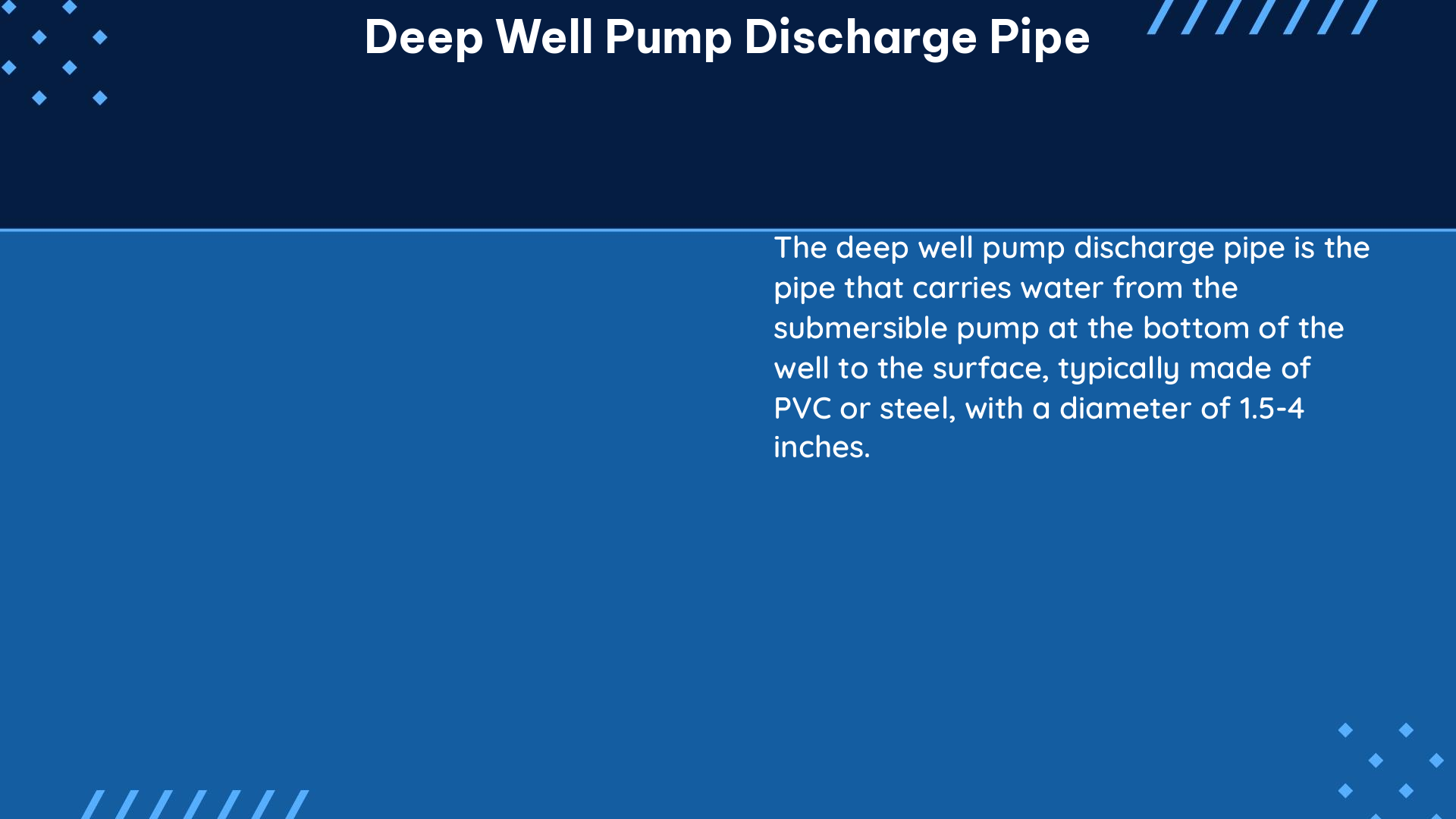The deep well pump discharge pipe is a critical component of a water well system, as it plays a crucial role in determining the overall performance and efficiency of the system. This comprehensive guide will delve into the technical details and provide a hands-on approach to understanding the intricacies of deep well pump discharge pipes.
Understanding the Importance of Pipe Size
The size of the deep well pump discharge pipe is a crucial factor that directly impacts the system’s performance. The pipe’s inside diameter (ID) determines the flow rate, friction loss, and overall system efficiency. Selecting the appropriate pipe size is essential to ensure optimal pump performance and longevity.
Pipe Diameter and Flow Rate
The flow rate of the water pumped from the well is directly proportional to the pipe’s inside diameter. A larger pipe diameter allows for a higher flow rate, which can be beneficial for meeting the water demand. However, it’s important to balance the pipe size with the pump’s capabilities to avoid oversizing or undersizing the system.
| Pipe Diameter (inches) | Flow Rate (GPM) |
|---|---|
| 1.25 | 6.6 |
| 1.5 | 9.2 |
| 2 | 16.5 |
| 2.5 | 25.8 |
Friction Loss and Pipe Length
The length of the deep well pump discharge pipe also plays a significant role in determining the friction loss. Longer pipes will experience higher friction losses, which can reduce the pump’s efficiency and increase the total dynamic head (TDH) required. The pipe’s material and roughness also contribute to the friction loss.
To calculate the friction loss in a deep well pump discharge pipe, you can use the following equation:
hf = 10.4057 x Q^1.85185 x L / d^4.87037
Where:
– hf is the friction loss (in feet)
– Q is the flow rate (in gallons per minute, GPM)
– L is the pipe length (in feet)
– d is the inside pipe diameter (in inches)
– C is the pipe material constant (150 for plastic pipes)
For example, in a system with a flow rate of 6.6 GPM, a 1.25″ PVC Schedule 40 column pipe with an ID of 1.38″ and a length of 260 ft, and a 1.5″ PE 4710 SR11 pipeline with an ID of 1.53″ and a length of 10 ft, the combined friction loss would be 2.33 ft.
Selecting the Appropriate Pump Discharge Port Size

When choosing a deep well pump, it’s essential to select a pump with a discharge port size that matches or exceeds the pipe’s inside diameter. Reducing the pipe size can cause the pump to work harder and wear out sooner, as it will have to overcome the increased friction loss.
As a general rule, it’s recommended to use piping that is the same size or larger than the pump’s discharge port, especially for above-ground pumps where the pressure switch is located near the pump. This ensures that the pump operates at its optimal efficiency and extends its lifespan.
Factors to Consider in Deep Well Pump Discharge Pipe Selection
When selecting the deep well pump discharge pipe, there are several factors to consider:
-
Pipe Material: Common materials used for deep well pump discharge pipes include PVC, polyethylene (PE), and stainless steel. Each material has its own advantages and disadvantages in terms of durability, corrosion resistance, and cost.
-
Pipe Schedule: The pipe schedule, or wall thickness, also plays a role in the pipe’s performance. Higher schedule numbers (e.g., Schedule 40) indicate thicker walls and higher pressure ratings.
-
Pipe Fittings: The type and quality of fittings used, such as elbows, tees, and unions, can impact the overall system’s efficiency and performance.
-
Pipe Supports: Proper pipe supports and anchors are essential to prevent sagging, movement, and potential damage to the pipe and the pump.
-
Pipe Insulation: In cold climates, insulating the deep well pump discharge pipe can help prevent freezing and ensure continuous water flow.
-
Pipe Accessibility: Consider the ease of access and maintenance when routing the deep well pump discharge pipe, especially in areas with limited space or difficult terrain.
Conclusion
The deep well pump discharge pipe is a critical component of a water well system, and its design and size significantly impact the system’s performance. By understanding the technical details and factors involved in selecting the appropriate pipe, you can ensure optimal pump efficiency, longevity, and overall system performance.
Remember to always consult with a professional or refer to industry guidelines and standards when designing and installing your deep well pump discharge pipe system.
References:
- NRCS USDA Technical Note: Design of Small Photovoltaic (PV) Solar-Powered Water Pump Systems, Appendix C, July 2017.
- Eng-Tips forum: Pump discharge line size calculation.
- DoItYourself.com Community Forums: Well pump discharge pipe size.
- YouTube: How to Measure Your Well Pump GPM.
- TerryLove.com Forums: Pump size and depth for existing deep well.

The lambdageeks.com Core SME Team is a group of experienced subject matter experts from diverse scientific and technical fields including Physics, Chemistry, Technology,Electronics & Electrical Engineering, Automotive, Mechanical Engineering. Our team collaborates to create high-quality, well-researched articles on a wide range of science and technology topics for the lambdageeks.com website.
All Our Senior SME are having more than 7 Years of experience in the respective fields . They are either Working Industry Professionals or assocaited With different Universities. Refer Our Authors Page to get to know About our Core SMEs.